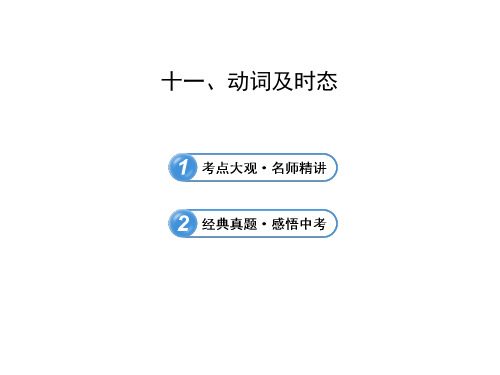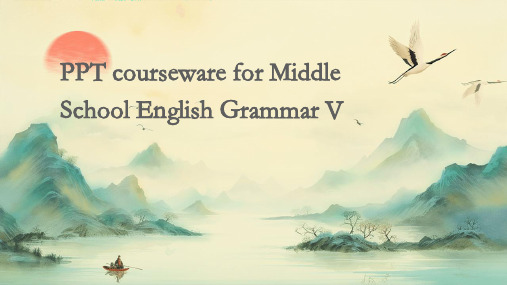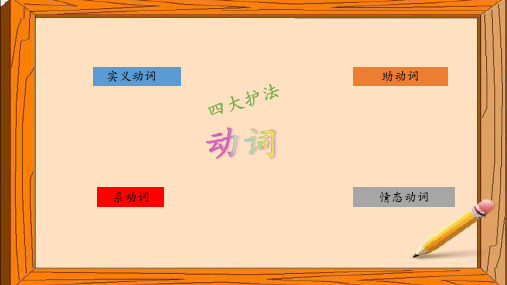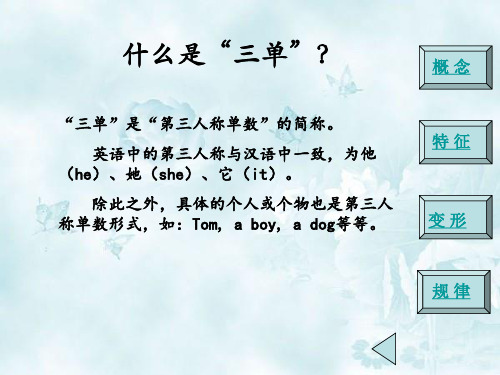初中英语语法—动词PPT课件
合集下载
动词及动词短语(63张PPT)初中英语专项复习课件

can not=can't
can
Can I go home now?我现在可以回
表示请求、允许,意为 家了吗?
“可以”,较口语化 You can tell him about that now.你现
在可以告诉他那件事了。
表示推测,意为“可能”, —Where can it be?它会在哪
常用于否定句和疑问句中。 儿?
satisfy 使满意
S save 挽救;节约
score 得分
search 搜索
seem 好像;似乎;看来 sell 卖
send 寄;送
separate 分离;分开
ser ve 服务;端菜
set 设置;摆放
shake 摇;握
share 分享
spread 传播;扩散
stand 站立;忍受
start 开始;出发 steal 偷 stick 粘;贴 store 储存 suggest 建议;暗示 suppose 认为
fail 失败 fall 掉落 fight 打架;争斗 finish 完成 follow 跟着;按照 form 形成
F feed 喂食 feel 感觉 fill 填满 fix 安装 force 强迫
grow 生长;种植 guess 猜
G guard 保卫 guide 引导;带领
hang 悬挂 hate 讨厌 hit 击;撞 hold 持有;握着;举行 hurry 匆忙
—Need I go there tomor row?明天 need 其引导的一般疑问句,
我需要去那儿吗? 肯定回答用 must,否定
—Yes,you must./No,you needn't. 回答用 needn't
can
Can I go home now?我现在可以回
表示请求、允许,意为 家了吗?
“可以”,较口语化 You can tell him about that now.你现
在可以告诉他那件事了。
表示推测,意为“可能”, —Where can it be?它会在哪
常用于否定句和疑问句中。 儿?
satisfy 使满意
S save 挽救;节约
score 得分
search 搜索
seem 好像;似乎;看来 sell 卖
send 寄;送
separate 分离;分开
ser ve 服务;端菜
set 设置;摆放
shake 摇;握
share 分享
spread 传播;扩散
stand 站立;忍受
start 开始;出发 steal 偷 stick 粘;贴 store 储存 suggest 建议;暗示 suppose 认为
fail 失败 fall 掉落 fight 打架;争斗 finish 完成 follow 跟着;按照 form 形成
F feed 喂食 feel 感觉 fill 填满 fix 安装 force 强迫
grow 生长;种植 guess 猜
G guard 保卫 guide 引导;带领
hang 悬挂 hate 讨厌 hit 击;撞 hold 持有;握着;举行 hurry 匆忙
—Need I go there tomor row?明天 need 其引导的一般疑问句,
我需要去那儿吗? 肯定回答用 must,否定
—Yes,you must./No,you needn't. 回答用 needn't
初中英语语法动词及时态ppt课件

过去进行时 主语+was/were+v. -ing+其他
现在完成时 主语+have/has+过去分词+其他
中学阶段见到的其他时态 时态
构成
过去完成时 主语+had+过去分词+其他
过去将来时
现在完成 进行时
主语+would+动词原形+其他 主语+was/were going to+动词原形
主语+have/has+been+现在分词+其他
状语
【温馨提示】
(1)在含有时间状语从句的复合句中,延续时间较长的动作用过 去进行时,另一个短暂性动作用一般过去时。例如:
My pen dropped on the ground when I was walking in the park. 在公园散步的时候,我的钢笔掉到地上了。
(2)表示两个延续性动作在过去某一时刻同时进行,不考虑动作 的先后顺序,主句和从句的谓语动词都用过去进行时,连词常 用while。例如:
词
宾语,又分为及物动词和 不及物动词。
物动 run , walk , cry , 词 swim,fall,happen
连
系 连接主语和表示主语身份、be , seem , look , become ,
动
性质、状态的动词称为连 get , grow , feel , appear ,
系动词。
turn
day等频率副词或时间状语 month.
连用
我们每月都去看望刘叔叔。
用法
例句
表示客观事实或普遍真理 The sun rises in the east. 太阳在东方升起。
《初中英语语法动词》课件

Auxiliary verbs
The auxiliary verb "be" is used to form the passive voice It is followed by the past particle form of the main verb
The auxiliary verb "do" is used to form questions and negative intentions It is followed by the infinitive form of the main verb
02
Types of verbs
Auxiliary verbs
Auxiliary verbs are used to form the perfect tense, the passive voice, and questions and negative sentences They include "have", "be", and "do"
Example: "I want to go to the park."
Subjunctive mood
The subcritical mood is used to express wishes, hypotheses, or emotions
It is characterized by the use of "were" instead of "is" in the present tense and "had" instead of "has" in the past tense
动词的分类(19张PPT)初中英语专项复习课件

动词是表示动作或状态的词。动词在句子中充当谓语,用来说明主语 是什么或做什么。
一、实义动词 实义动词,含有实际意义,表动作或状态,可独立做谓语。 动词按照其后是否能跟宾语可分为及物动词和不及物动词。 1.及物动词 及物动词就是后面必须跟宾语意义才完整的动词。如 love,need,want,ask,have,help,teach,make等。 I love my mother.我爱我的母亲。
2.不及物动词 (1)不及物动词本身意义完整,其后不必跟宾语。如 come,go,run,travel,listen,swim,live,work等。 The man works hard.这个人工作很努力。 (2)如果需要带宾语,则不及物动词需要跟适当的介词连用。 Look at the blackboard.看黑板。 动词按照其是否具有延续性,又可分为延续性动词和短暂性动词。 1.延续性动词,如:study,sleep,live,stay。延续性动词常和能表示 一段时间的状语连用。 2.短暂性动词,如:begin,buy,borrow,die。短暂性动词不能与表示一 段时间的状语连用。
go,turn 等
布莱克先生的脸变红了。
keep,stay, remain 等
The shop stays open till 8 in the evening. 商店一直营业到晚上 8 点。
三、助动词 助动词本身没有意义,不能单独做谓语,只能和别的动词一起构成谓语, 表示时态、语态、语气等特征,帮助构成否定、疑问、强调、省略等。 主要的助动词有be,do,have,shall,will等。
I have borrowed that book for one month.(×)
I have kept that book for one month.(√)
一、实义动词 实义动词,含有实际意义,表动作或状态,可独立做谓语。 动词按照其后是否能跟宾语可分为及物动词和不及物动词。 1.及物动词 及物动词就是后面必须跟宾语意义才完整的动词。如 love,need,want,ask,have,help,teach,make等。 I love my mother.我爱我的母亲。
2.不及物动词 (1)不及物动词本身意义完整,其后不必跟宾语。如 come,go,run,travel,listen,swim,live,work等。 The man works hard.这个人工作很努力。 (2)如果需要带宾语,则不及物动词需要跟适当的介词连用。 Look at the blackboard.看黑板。 动词按照其是否具有延续性,又可分为延续性动词和短暂性动词。 1.延续性动词,如:study,sleep,live,stay。延续性动词常和能表示 一段时间的状语连用。 2.短暂性动词,如:begin,buy,borrow,die。短暂性动词不能与表示一 段时间的状语连用。
go,turn 等
布莱克先生的脸变红了。
keep,stay, remain 等
The shop stays open till 8 in the evening. 商店一直营业到晚上 8 点。
三、助动词 助动词本身没有意义,不能单独做谓语,只能和别的动词一起构成谓语, 表示时态、语态、语气等特征,帮助构成否定、疑问、强调、省略等。 主要的助动词有be,do,have,shall,will等。
I have borrowed that book for one month.(×)
I have kept that book for one month.(√)
初中英语语法-动词复习课件(PPT24张)

B. must
C. dare
D. would
visited 1. They ________ (visit) the museum last week. has made (make) many friends since she came to Paris. 2. Zhang Hong ________ will go 3. She ________ (go)to the cinema with her classmates tomorrow evening. sleeps 4. John is always busy. He ________ (sleep) only six hours very night. is raining (rain) now. 5. Stay here; boy; don't go out. It ________
☆ should 表示义务、责任 We should obey traffic rules. ☆ shall
征求意见(第一人称)
Shall we go shopping today?
警示、命令、允诺(第二、三人称)
You shall hand in your homework on time.
will vs would
☆
描述状态变化过程
He is getting worse and worse.
The man fell asleep two hours ago. It's growing warm. Maple trees turn red in autumn.
The sun rose red. She stopped and stood quite still. The book lay open on the table. He married young.
初中英语动词-动词的第三人称单数形式课件(共18张PPT)

概念 特征 变形 规律
概念
1.My teacher sp_e_a_ks (speak) 特征 Chinese well.
2.She lo_v_e_s (love)reading变.形 3.Ted h_a_s_ (have) a brother. 4. I _a_m_(is, am, are) a stude规nt律.
play
规律
5. They can speak English概 念.
否定:can
can not
特征
6.It love eating meat. (love变)形
否定:loves
doesn’t love 规律
7. This is an apple.
概念
否定: is is not
8. Grace’s father spends 特 征
5.You s_tu_d_y (study) English w概 e念ll. 6.We _lik_e_(like) singing.
7.John sp_e_n_ds (spend) a lot o特f征
time with TV.
8.
My
brotherwa_t_c_hes(watch变)
形
TV
every night.
变形
如上所示,当主语为第三人称单数时,动词要 做相应的变化,这就是动词的“三单”形式。 动词第三人称单数一般以-s, -es, -ies结尾。
规律
动词“三单”的变化
get
make
read
live
walk
eat
概念 特征
gets makes
reads lives
walks
动词及动词短语(17张PPT)初中英语专项复习课件

动
词
的
第 ①一般动词在词尾加-s。如:look-looks; get-gets
基
动 词 和
动本 词
形
三 ②以s, x, sh, ch结尾加-es。如:address-addresses; box-boxes; finish人 finishes; touch-touches
动
称 ③以"辅音字母+y"结尾的词,变y为i加-es。如:study-studies
动词
中考主要是在语境中对动词进行考查,常见命题角度: (1)实义动词辨析。 中考选择填空和完形填空中都常涉及对实义动词辨析的考查,做题时: ✓ 首先要明确动词的含义; ✓ 然后通过分析语境找出关键词,或根据前后的逻辑关系确定答案。
动词
常考的几组近义动词: ①divide与separate ②hear, listen与sound ③invent, discover, create与find ④cost, spend, pay与take
规 则 变 化
过去分词
不规则变 化
动
词
的
基
动 词 和 动 词
动本 词
形 式
①一般动词在词尾加-ing:go-going; look-looking ②以不发音的e结尾的词,去e加-ing:come-coming; use-using 现 ③以辅音字母结尾的重读闭音节词,双写该辅音字母加-ing:begin在
类
sound, seem, feel, stay, turn, get, keep, remain
助动词 没有词义,不能单独作谓语:be, do/does/did, have/has/had, will, shall
初中英语语法全解——动词(共23张PPT)

3.表示转变和结果的连系动词 常见的有become,grow,turn,fall,get,go。 The weather became warmer.
(3)助动词 1.be (1)am,is,are,was,were与现在分词连用构成 进行时。 Don’t disturb me while I’m working. (2)am,is,are,was,were与过去分词连用构成 被动语态。 Smoking is not permitted.
2.could (1)could是can的过去式。表示过去的能力。 I was just a little boy and I couldn’t keep the secret. (2)could在疑问句中,表示提议和请求,语气比 can更委婉。 Could you help me with these boxes? (3)could表示推测,意为“可能”,表示把握不大。 Most accidents in the home and could be prevented.
6.need need表示“需要”,常用于否定句和疑问句中, 由need引出疑问句,肯定回答用must,否定回 答用needn’t。 ---Need we take the test? ---Yes, we must.
7.have to
have to表示“必须,不得不”,有人称、数和 时态的变化,变为否定句和疑问句时,要用助动 词do,does,did来构成。have to多强调由于客 观需要而“不得不”;而must多强调主观上的 原因。
4.might might是may的过去式,常用于表示推测,其可 能性不大,语气比may弱。 She might not want to come with us.
- 1、下载文档前请自行甄别文档内容的完整性,平台不提供额外的编辑、内容补充、找答案等附加服务。
- 2、"仅部分预览"的文档,不可在线预览部分如存在完整性等问题,可反馈申请退款(可完整预览的文档不适用该条件!)。
- 3、如文档侵犯您的权益,请联系客服反馈,我们会尽快为您处理(人工客服工作时间:9:00-18:30)。
_tr_a__n_s_f_e__r,__b_e__c_a_m__e__________________________________
助动词:_w_i_ll_, _h_a_v_e_n_’_t,_s_h_o_u_l_d_,_d_o_e_s_,_d_i_d_n_’t_____________
.
9
Practice Oral Practice
用所给词的适当形式填空,并朗读句子 My parents ___a_r_e___ (be) at home now, but they ___w_e_r_e__ (be) in the park just now.
I ___d_o_n_’t__l_ik_e__ (not like) cats, but my mother ___l_ik_e_s_______ (like) cats.
I like fruit. He has got three big toys.
否定句:
主语+助动词do/does+not+实义动
词原形+其他
主语+主动动词not+动词形式+其他
句 型 结 构
一般疑问句: 助动词Do/Does+主语+实义动词原 形+其他? 助动词+主语+动词形式+其他?
I don’t like fruit. He won’t go fishing. Do you like fruit? Have you ever read this book?
结 一般疑问句:Be+主语+其他? Is he a police officer?
构
他是警察吗?
特殊疑问句:
What is he?
特殊疑问词+be+主语+其他? 他是做什么的?
.
7
Presentation Grammar Box
实义动词和助动词的句型结构
肯定句: 主语+实义动词+其他 主语+助动词+动词形式+其他
今天我们来学习be 动词、实意动词和助动词。
.
4
Presentation
Look and Say
.
5
Presentation Sentences
阅读并翻译例句。通过句意来观察并总结句型中经 常出现的be动词、实义动词和助动词有哪些。
He is in Class One, Grade Two.
We are not playing at home.
.
3
Warm up
除了省略句,句子中不能没有动词。最常见的动词有 两种:一种是be动词,另一种是实义动词。当含有实义动 词的句子进行句型转换或时态变化时,需要添加进来的词 被称之为助动词。
助动词顾名思义就是帮助动词完成句型结构和时态以 及数的变化,而能使用助动词的也只有实意动词。原因是 通常be动词提前或者do后加not就能够直接变成疑问句或 者否定句的变化,而实意动词不能所以需要借助助动词的 帮助。
特殊疑问句:
特殊疑问词+ do/does+主语+实义 What do you like?
动词原形+其他?
特殊疑问词+助动词+主语+动词形 Where has he been?
式+其他?
.
8
Practice Oral Practice
把下列单词正确分类,并朗读出来。
will care feel like is haven’t get are search should become read does am cook d up
读一读,圈出句子中的动词
There is some ice on the car. We went to the zoo last year. She didn’t finish her homework. She plays ping pong every day. Lucy doesn’t want to be a football player.
Where ___w_e_r_e___ (be) you yesterday morning? I ___w_a_s___ (be) ill in the bed.
— __D_o_e_s__ Miss Li __c_o_m__e__ (come) from Nanjing?
— No, she ____i_s____ (be) from Shanghai.
What would you do if you go to college?
.
6
Presentation Grammar Box
系动词be的句型结构
肯定句:主语+系动词be+其他 He is a police officer. 他是一名警察。
句 否定句:主语+be+not+其他 型
He is not a police officer. 他不是警察。
Is there any soup in the bowl?
What is the color of the door?
He plays basketball with his friends every day.
He didn’t go skating last year.
Have they been to America?
want love
特殊系动词:_fe_e_l_, _g_e_t ______________________________
be动词:__a_m__,_is_,_a_r_e__________________________
实义动词:_c_a_re_,_l_ik_e_,_w__a_n_t,_s_e_a_r_c_h_,_r_e_a_d_,_lo__v_e_, _co__o_k_, ____
Unit 7
Link Verb, Notional Verb and Auxiliary Verb
系动词、实义动词和助动词
Warm up
Presentation
Practice
Production
.
1
Warm up
读一读,圈出句子中的动词
How is the girl in the dining room? What is the color of the door? Where were you last Saturday? How was the movie? There are seven monkeys in the tree.
